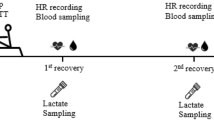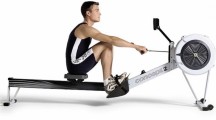Summary
Five university oarsmen participated in a determination of mechanical efficiency when rowing in a tank. In the tank, water was circulated at 3 m · s−1 by a motor driven pump. The subjects rowed with the stepwise incremental loading, in which the intensity increased by 10% of the maximum force of rowing (max FC) every 2 min. Power (\(\dot W\) O) was calculated from the force applied to the oarlock pin (FC) and its angular displacement (θH). Oxygen uptake and heart rate were measured every 30 s during rowing. Anaerobic threshold (AT) was determined from expired gas variables by Wasserman's method. AT of oarsmen was 74.6±6.01% as a percentage of \(\dot V_{{\text{O}}_{\text{2}} {\text{max}}}\). As the displacement of the handgrip in the stroke was independent of \(\dot W\) O, the increment of \(\dot W\) O was caused by the increase of both FC and stroke frequency. Gross efficiency without base-line correction (GE) increased with FC with low intensities of rowing. In the region of 124–182 W of \(\dot W\) O GE was almost constant at 17.5%. Efficiency was 19.8±1.4%, with resting metabolism as base-line correction (net efficiency), and 27.5±2.9% when using the unloaded rowing as the base-line correction (work efficiency), and 22.8±2.2% when calculating the work rate as the base-line correction (delta efficiency).
Similar content being viewed by others
References
Asami T, Adachi N, Yamamoto K (1981) Biomechanical analysis of rowing performances. In: Morecki A, Fidelus K, Kedzior K, Wit A (eds) Biomechanics VII-B. University Park Press, Baltimore, pp 442–446
Asmussen E (1946) Aerobic recovery after anaerobiosis in rest and work. Acta Physiol Scand 11:197–210
Cavagna GA, Kaneko M (1977) Mechanical work and efficiency in level walking and running. J Physiol 268:467–481
Christensen EH, Hogberg P (1950) The efficiency of anaerobical work. Arbeitsphysiologie 14:249–250
Cunningham DA, Goode PB, Critz JB (1975) Cardiorespiratory response of exercise on a rowing and bicycle ergometer. Med Sci Sports 7:37–43
Diem K (1962) Documenta Geigy Scientific Tables (6th ed) Ardsley NY: Geigy Pharmaceuticals, pp 628
DiPrampero PE, Cortile G, Celentano F, Cerretelli P (1971) Physiological aspects of rowing. J Appl Physiol 31:853–857
Gaesser GA, Brooks GA (1975) Muscular efficiency during steady rate exercise: effects of speed and work rate. J Appl Physiol 38:1132–1139
Hagerman FC, Conners MC, Gault JA, Hagerman GR, Polinski WJ (1978) Energy expenditure during simulated rowing. J Appl Physiol 45:87–93
Henderson Y, Haggard HW (1925) The maximum of human power and its fuel. Am J Physiol 72:264–282
Mickelson, TC, Hagerman, FC (1982) Anaerobic threshold measurements of elite oarsmen. Med Sci Sports Exerc 14:440–444
Thys, H, Faraggiana T, Margaria R (1972) Utilization of muscle elasticity in exercise. J Appl Physiol 32:491–494
Wasserman K, Whipp BJ, Koyal SN, Beaver WL (1973) Anaerobic threshold and respiratory gas exchange during exercise. J Appl Physiol 35:236–243
Whipp BJ, Wasserman K (1969) Efficiency of muscular work. J Appl Physiol 26:644–648
Author information
Authors and Affiliations
Rights and permissions
About this article
Cite this article
Fukunaga, T., Matsuo, A., Yamamoto, K. et al. Mechanical efficiency in rowing. Europ. J. Appl. Physiol. 55, 471–475 (1986). https://doi.org/10.1007/BF00421639
Accepted:
Issue Date:
DOI: https://doi.org/10.1007/BF00421639




